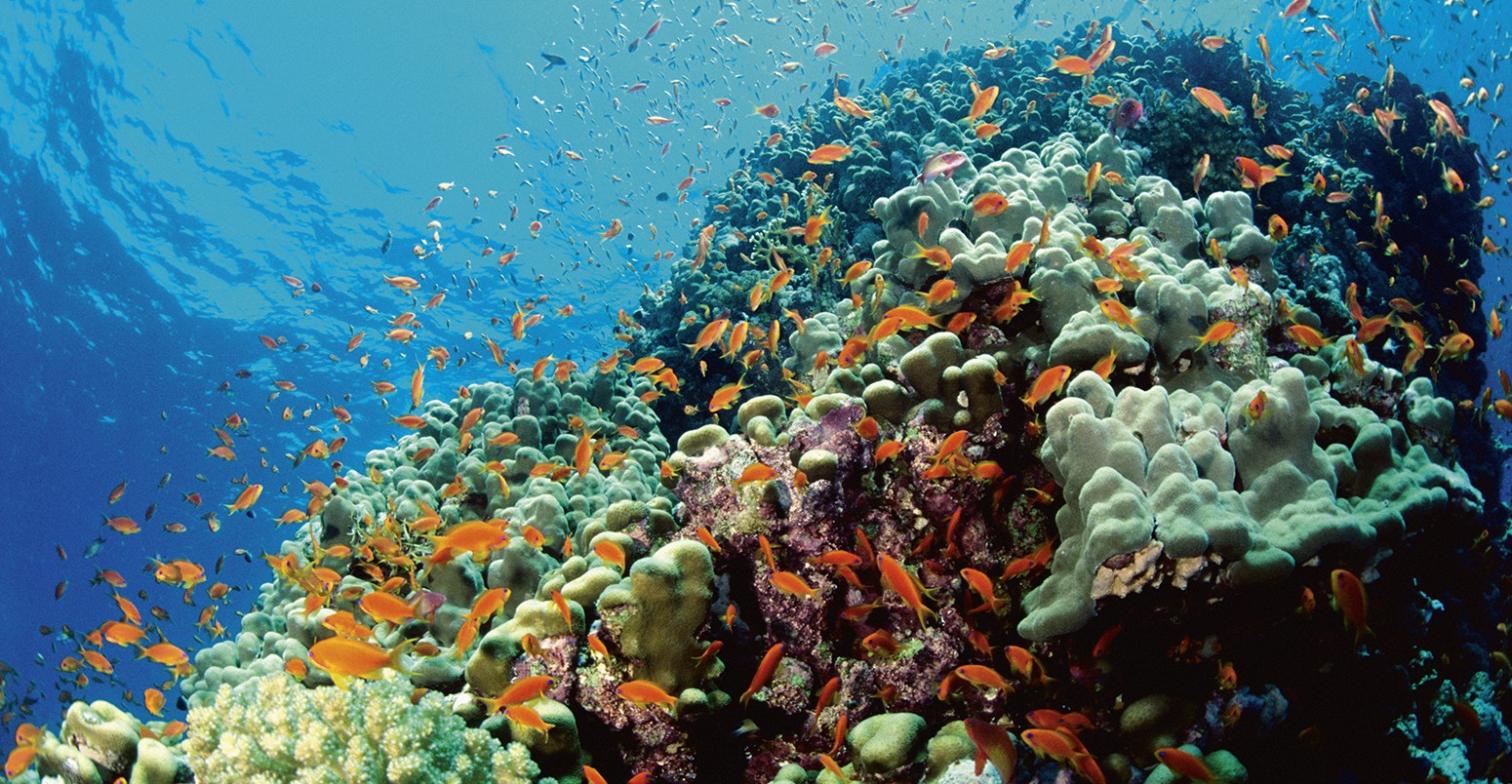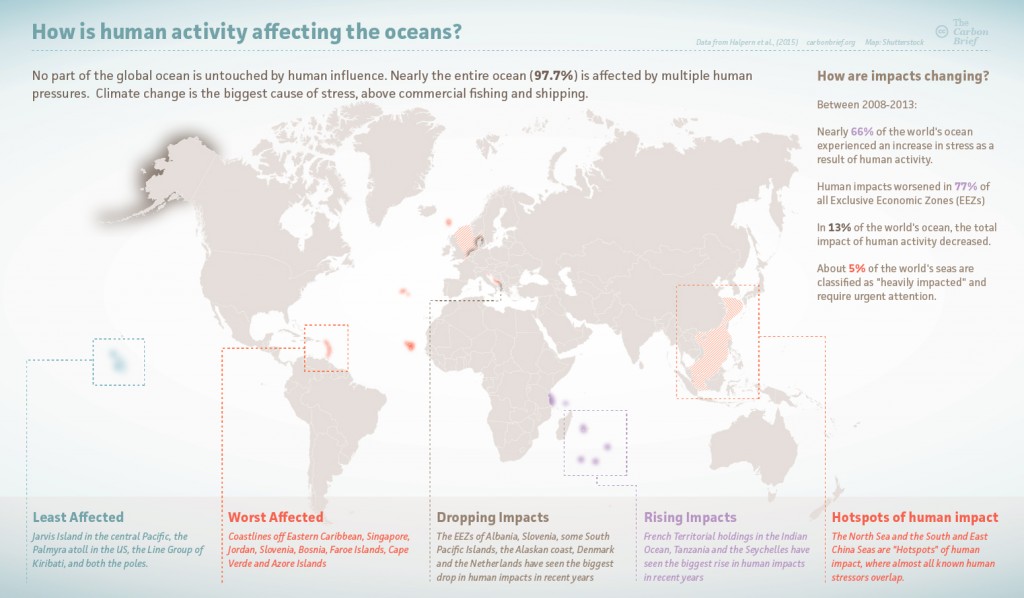
Climate change is biggest cause of stress on world’s oceans
Roz Pidcock
07.15.15Stark new research shows the extent to which humans are affecting the oceans, with only the most remote corners emerging relatively unscathed.
Nowhere is without human influence entirely, says the study in Nature Communications, and nearly the entire surface of the ocean (97.7%) suffers under more than one pressure.
Climate change “dominates humanity’s footprint” on the oceans, coming in above commercial fishing, pollution and shipping, the authors conclude.
Stress-mapping
The study looks at 19 different ways human activity can cause damage to marine ecosystems, known as “stressors”.
These include climate-related impacts – such as rising temperatures, acidifying oceans and exposure to UV radiation – as well as pollution, fertiliser run-off, marine traffic and fishing.
As the authors say in the paper:
“The ocean is crowded with human uses…Marine species and habitats have long experienced detrimental impacts from human stressors, and these stressors are generally increasing globally.”
The team of 11 researchers hail from the University of California, the Hawaii institute of Marine Biology, Scripps Institution of Oceanography, the US National Oceanic and Atmospheric Administration (NOAA), Conservation International and Imperial College London in the UK.
The study is the first to map how different types of stress caused by human activity add up in different parts of the world’s oceans, and how quickly things are changing.
The scientists assigned an impact “score” to each part of the world, according to how vulnerable different types of marine habitat (eg. saltmarsh, coral reefs, mudflats) are to each human stressors. Then, they added the scores together to get a total impact score.
Total human impact on the world’s oceans. Data taken from Halpern et al., (2015) and adapted by Rosamund Pearce, Carbon Brief. Click to enlarge.
The North Sea and the South and East China Seas are classed as ocean impact “hotspots”, where almost all known human stressors overlap.
The worst-affected geographical areas are the coastlines off Singapore, Jordan, Slovenia, Bosnia, Faroe Islands, Eastern Caribbean, Cape Verde and Azore Islands.
The least affected regions are mainly near the poles, but also include Jarvis Island in the central Pacific, the Palmyra Atoll in the US and the Line Group of Kiribati, the paper says.
Climate impacts
The researchers examined which of the individual human stressors were responsible for the biggest negative impacts across the world.
They found that climate-related impacts cause more stress to oceans than any other type of human activity. This is because warmer, more acidic water affect the whole ocean whereas things like shipping, fishing and pollution have more local effects.
Below is a chart from the paper’s supplementary information showing how climate-related impacts contribute to the total impact “score” in the 80 most-affected countries.
You can see the combined effects of temperature change, ocean acidification and increasing UV radiation (all shown in blue) are typically large compared to other impacts.
Comparing the contributions of each type of human stressor to the overall impact score in the 80 most-affected countries, from highest to lowest. Climate-related impacts are shown in blue. Source: Halpern et al., (2015) Click to enlarge.
Big changes
The team also looked at how human impacts changed in different parts of the world between 2008 and 2013. They chose 12 stressors with the most complete global data, so that they could be compared over time.
Nearly 66% of the global ocean experienced a rise in total human impact over the five-year period. This included 77% of all Exclusive Economic Zones (EEZs) – the area up to 200 nautical miles from a country’s coast, to which it has special exploration rights.
Rising impacts tended to be in tropical, subtropical and coastal regions, with Tanzania, the Seychelles and Indian Ocean French territories seeing the biggest rises in recent years.
Some places that had previously scored low in terms of human impacts saw big increases , including many offshore regions in the subtropical Atlantic and Indian Oceans.
On the other hand, some heavily-impacted places, such as the North Sea, the Mediterranean Sea and the South China Sea, saw human impacts drop a bit.
Globally, the researchers found that increases in climate stressors again accounted for most of the increase in the total human impact over the study period.
The map below shows the change in impact on the ocean from sea surface temperature change between 2008-2013. Red is increasing impact, blue is decreasing.
Map showing changes in impact score from sea surface temperature between 2008-2013. Red is increasing, blue is decreasing. Source: Halpern et al., (2015) Click to enlarge
Priorities
Based on their results, the team classified 5% of the global ocean as “heavily impacted”, meaning stressors are high and growing. These areas require urgent attention, they say.
But it’s not all bad news. In 13% of the ocean, including the Northeast and Central Pacific and Eastern Atlantic, the total effects of human activity appear to be dropping.
The researchers found the biggest decreases in the EEZs of some remote South Pacific Islands, the Alaskan coast, Slovenia, Albania, Denmark and the Netherlands.
The paper explains:
“These patterns of change in pressures over time offer guidance on where mitigation efforts are most neededâ?¦and where past management actions may be paying dividends.”
But while some places may have seen improvements in one or more type of human stressor, the overall impact of human activity is increasing, especially in coastal areas where populations are growing the fastest, the paper notes,
Capturing impact
There are a few things to note about the study. First, the short time period doesn’t fully take account of natural fluctuations from one decade to the next. But as the authors say in the paper, it is sufficient to provide an indication of the direction of human caused change.
Also, the study doesn’t include all human impacts on the ocean. The paper explains:
“Several known stressors to marine systems could not be included because of insufficient global data, including offshore energy infrastructure (for example, wind farms, submerged pipes and cables, deep sea mining, marine debris).”
Whether or not it will ever be possible to fully capture humanity’s impact on the oceans, this study is clear about the many and varied ways that climate change is playing a role, and the stark pace of change that continues unchecked in the majority of global waters.
Main image: Fish in Coral Reef.
Halpern, B.S. et al., (2015) Spatial and temporal changes in cumulative human impacts on the world's ocean. Nature Communications. DOI:10.1038/ncomms8615
-
New research shows the extent to which humans are affecting the oceans, with only the most remote corners emerging relatively unscathed




